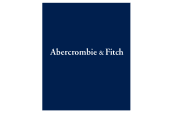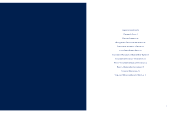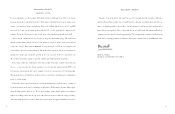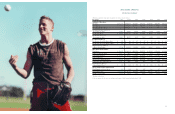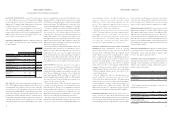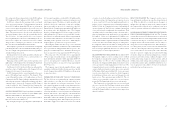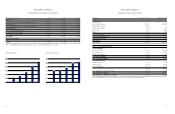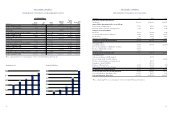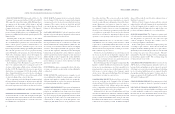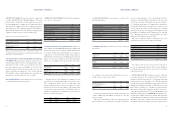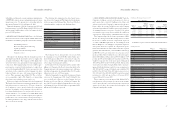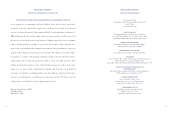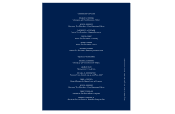Abercrombie & Fitch 1999 Annual Report Download - page 11
Download and view the complete annual report
Please find page 11 of the 1999 Abercrombie & Fitch annual report below. You can navigate through the pages in the report by either clicking on the pages listed below, or by using the keyword search tool below to find specific information within the annual report.
17
2000 for capital expenditures, of which $60 to $70 million will be
for new stores, remodeling and/or expansion of existing stores and
related improvements. The balance of capital expenditures will
chiefly be related to the construction of a new office and distri-
bution center which is expected to be completed in early 2001.
During 1999, the Company spent approximately $27 million on
the new home office and distribution center. The Company
intends to add approximately 560,000 gross square feet in 2000,
which will represent a 26% increase over year-end 1999. It is antic-
ipated the increase will result from the addition of approximately
45 new Abercrombie & Fitch stores, 40 abercrombie stores and the
remodeling and/or expansion of four stores. Additionally, the
Company plans to open five new concept stores in 2000.
The Company estimates that the average cost for leasehold
improvements and furniture and fixtures for Abercrombie & Fitch
stores opened in 2000 will approximate $650,000 per store, after
giving effect to landlord allowances. In addition, inventory pur-
chases are expected to average approximately $300,000 per store.
The average size of the abercrombie stores is approximately
4,400 gross square feet and the average cost for leasehold improve-
ments and furniture and fixtures will be approximately $450,000
per store, after giving effect to landlord allowances. In addi-
tion, inventory purchases are expected to average approximately
$150,000 per store.
The Company expects that substantially all future capital
expenditures will be funded with cash from operations. In addi-
tion, the Company has available a $150 million credit agreement
to support operations.
INFORMATION SYSTEMS AND “YEAR 2000” COMPLIANCE
The Year 2000 issue arose primarily from computer programs
which only have a two-digit date field, rather than four, to
define the applicable year of business transactions. Because
such computer programs are unable to properly interpret dates
beyond the year 1999, a systems failure or other computer errors
could have ensued. The Company relies on computer-based
technology and utilizes a variety of proprietary and third party
hardware and software. The Company’s critical information
technology (IT) functions include point-of-sale equipment,
merchandise and non-merchandise procurement and business
and accounting management. The Company also procures its
merchandise, supplies and certain services from a vast network
of vendors located both within and outside the United States.
At the present time, the Company has not experienced, nor is
it aware of any Year 2000 issues that might materially affect its
products, services, competitive position or financial performance.
At July 31, 1999, the Company had incurred substantially all
expenses relating to the Year 2000 issue, consisting of internal staff
costs as well as outside consulting and other expenditures. Total
expenditures related to remediation, testing, conversion, replace-
ment and upgrading system applications were approximately
$4.0 million. Of the total, approximately $1.0 million were
expenses associated with remediation and testing of existing sys-
tems. In 1999 and 1998, a significant amount of total internal staff
resources were directed toward Year 2000 projects. Subsequent to
the completion of Year 2000 remediation of existing systems and
implementation of new systems, internal resources and costs
have not changed significantly but have been redirected from
Year 2000 projects to other Company initiatives.
RELATIONSHIP WITH THE LIMITED Effective May 19, 1998,
The Limited completed a tax-free exchange offer to establish
the Company as an independent company. Subsequent to the
Exchange Offer (see Note 1 to the Consolidated Financial
Statements), the Company and The Limited entered into various
service agreements for terms ranging from one to three years. The
Company has hired associates with the appropriate expertise or
contracted with outside parties to replace those services provided
by The Limited which expired in May 1999. Service agreements
were also entered into for the continued use by the Company of
its distribution and home office space and transportation and
logistic services. These agreements expire in May 2001. The cost
of these services generally is equal to the costs and expenses
incurred by The Limited plus five percent of such amounts.
The Company does not anticipate that costs associated with
the services provided by The Limited, which expire in May
2001, or costs incurred to replace the services currently pro-
vided by The Limited will have a material adverse impact on its
financial condition.
Abercrombie &Fitch Co.
16
Net cash provided by operating activities totaled $153.8 million,
$173.1 million and $100.2 million for 1999, 1998 and 1997.
In 1999, net cash provided by operating activities was largely
due to current year net income. Cash requirements for inventory
increased $31.3 million during 1999. The increase in inventory
was necessary to support the growth in sales as well as increased
investment in non-seasonal “locker stock” items (primarily tee
shirts). The inventory increase also reflects the early delivery of
a portion of Spring receipts to reduce the potential risk related to
Year 2000 issues. Accounts payable and accrued expenses
increased primarily due to the increase in the liability for the esti-
mated costs to complete the construction of new stores and the
change in the accounting for gift certificates (as described in
Note 14 to the Consolidated Financial Statements).
The Company’s operations are seasonal in nature and typically
peak during the back-to-school and Christmas holiday selling sea-
sons. Accordingly, cash requirements for inventory expenditures
are highest during these periods.
Investing activities were for capital expenditures, which are pri-
marily for new and remodeled stores, and for purchases of
short-term marketable securities.
Financing activities in 1999 consisted of the repurchase of 1.5
million shares of the Company’s Class A Common Stock pursuant
to a previously authorized stock repurchase program.
On February 14, 2000, the Board of Directors authorized the
repurchase of up to 6.0 million shares of the Company’s Class A
Common Stock for general corporate purposes.
In 1998, financing activities consisted primarily of the repay-
ment of $50 million long-term debt to The Limited. This
occurred through the issuance of 1.2 million shares of Class A
Common Stock to The Limited with the remaining balance paid
with cash from operations. Additionally, settlement of the inter-
company balance between the Company and The Limited
occurred on May 19, 1998. During 1998, the Company also
repurchased 490 thousand shares of Class A Common Stock.
CAPITAL EXPENDITURES Capital expenditures, primarily for
new and remodeled stores, amounted to $83.8 million, $41.9
million and $29.5 million for 1999, 1998 and 1997.
During the year, the Company opened 32 Abercrombie &
Fitch stores and 22 abercrombie stores.
The Company anticipates spending $150 to $160 million in
Abercrombie &Fitch Co.
IMPACT OF INFLATION The Company’s results of opera-
tions and financial condition are presented based upon historical
cost. While it is difficult to accurately measure the impact of
inflation due to the imprecise nature of the estimates required,
the Company believes that the effects of inflation, if any, on its
results of operations and financial condition have been minor.
SAFE HARBOR STATEMENT UNDER THE PRIVATE SECUR-
ITIES LITIGATION REFORM ACT OF 1995 The Company
cautions that any forward-looking statements (as such term is
defined in the Private Securities Litigation Reform Act of 1995)
contained in this Report or made by management of the
Company involve risks and uncertainties and are subject to
change based on various important factors. The following fac-
tors, among others, in some cases have affected and in the future
could affect the Company’s financial performance and could
cause actual results for 2000 and beyond to differ materially
from those expressed or implied in any such forward-looking
statements: changes in consumer spending patterns, consumer
preferences and overall economic conditions, the impact of com-
petition and pricing, changes in weather patterns, political
stability, currency and exchange risks and changes in existing or
potential duties, tariffs or quotas, availability of suitable store loca-
tions at appropriate terms, ability to develop new merchandise
and ability to hire and train associates.



